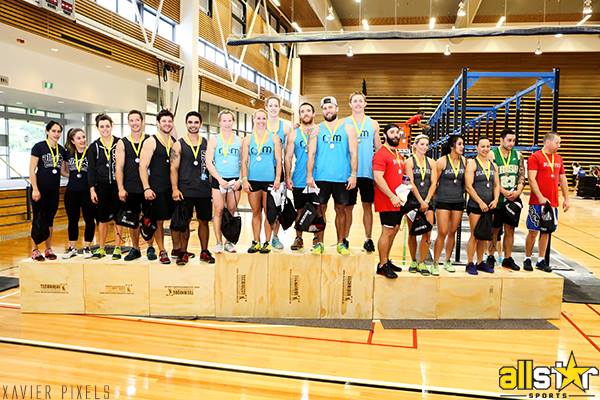Check out the Allstars Affiliate Series App for the Perth scoreboard and target times/scores.
Event 1:
- Rank your three guys based on their rowing ability. Rank your three girls based on their overall ability to complete the row+deads. This is your starting order.
- The deadlifts don’t mean anything for the guys as it’s very easy to finish the deads faster than the next girl finishes the row. When the guy gets off the rower, have them perform five quick reps, then another five every time the team signals that the girl on the rower has rowed five cals. This allows you to save the posterior chain for the snatch.
- The guy has to row at max effort – the row time is the only conribution the guy makes to the team’s score.
- For the girl it’s much simpler/more painful. Treat it simply as a row/deadlift workout and pace it as such. Sacrifice rowing speed for deadlift stamina.
Event 2:
- Time is a massive factor here (30 secs per lift including plate changes), so be organised with your three intended attempts beforehand. We listed our 18 lifts from lightest to heaviest and worked through in this order. Sacrifice rest between lifts for the time to complete all 18.
- Consider lifting 2.5kg less if it means you can avoid a plate change. You’ll make up for it by completing all lifts.
- Take your lifting order out onto the competition floor with you. It’s everyone’s responsibility to know their next lift and the plate change required.
Event 3:
- The final person to lift in event two should be the final person to complete event 3. The order is unimportant from a strategy point of view, so maximise the rest after the snatch.
- Watch the clock, or have team mates notify you of remaining time.
- Predict (or attempt if long enough before the event) your max reps of each variation and multiply your scores by 1, 2 or 5 to determine the best variant for you.
Event 4:
- Choose the most challenging (ie: slowest) movement (out of bj and t-b) for your team (will be toes to bar for low to medium level teams and box jumps for top level teams). You need to strategise around this movement. If you have one person weak at this movement, pair them with the strongest member of your team on this movement to minimise the damage.
- If all six members are strong at everything, pair 1st guy with 3rd girl, 1st girl with 3rd guy and 2nd girl with 2nd guy.
- Time to complete all three elements is very similar for a competent team.
- The technique for the box jump overs is paramount. We saw many variations in technique (including alternating partners each jump) but we trialed all these alternatives and found that this technique was fastest (three sets of ten reps each).
Event 5:
- As with event four, work around your team’s weakness here. DU are the most important element for strong teams, HSPU for weaker teams.
- If you have one team member who is very weak at one movement, make sure you pair them with the strongest member of the opposite gender in this movement.
- If you have a strong team, non of the elements will challenge you, but the DU will be slowest by far, so select your pairings based on the need to find time here. Pair your slowest and fastest DU athletes together.
- We broke our snatches 6/5/4 each. The rep ends with the lockout overhead, so theoretically, you can have both athletes moving simultaneously if you can both complete 15 reps unbroken (one locks out, the other begins the lift and by the time they’ve locked out, the first person has the bar tapping the ground). This will take some practice.
- We just did one set of HSPU each. If you can do them strict, consider smaller sets.
Event 6:
- For the guys, the workout ends after the first round. The girls will not catch you. Because of this, you need to go all out in this first round, knowing you can then switch off and cruise the remainder. Max speed on the squats with minimal change overs. I’ll discuss burpee technique shortly. Once the guys have finished the first round, don’t let your ego fatigue you for the final event – you’ve got plenty of time to slowly work through the remainder.
- For the girls, the event is much longer, with a requirement to maintain speed throughout. There’s plenty of rest so gaming shouldn’t be excessive.
- Burpee strategy is key. Again, we saw a huge variety of techniques here. The important burpee sets are the first set for the guys, and all sets for the girls. The strategy is pretty simple, very fast and not fatiguing. You’ll have two people starting on one side of the bar and one person on the other. You’ll complete one rep each, jumping to the empty space on the other side of the bar (which will occasionally be diagonal). As soon as someone lands on your side of the bar (watch their feet), begin your rep. You can see one cycle of this pattern below.

 Event 7:
Event 7:
- Put your fastest team member first (if you’ve got two of similar speed, go with the one with the best grip stamina). The first person will probably be the only person who goes through without a rest. Every other team member will have to wait a short amount of time (<10 secs for strong teams) after the cleans.
- Muscle clean if you can, but not if it’s going to be at the detriment of your ability to do the pull-ups unbroken.
- If pull-ups are going to be the limiting factor for your team, order both the guys and girls so the strongest at pull-ups is first, the weakest is second and the middle athlete is third. This will allow you to get your weakest at pull-ups as long on the bar as possible (because the strongest has completed them quickly) before the person behind them finishes the swings. The only exception is if you don’t think you’ll make the time cap, in which case you simply order strongest to weakest.


Photo courtesy Xavier Pixels





